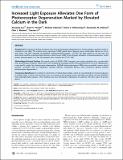| dc.contributor.author | Liu, Xiaoqing | |
| dc.contributor.author | Pawlyk, Basil | |
| dc.contributor.author | Adamian, Michael | |
| dc.contributor.author | Olshevskaya, Elena V. | |
| dc.contributor.author | Dizhoor, Alexander M. | |
| dc.contributor.author | Makino, Clint L. | |
| dc.contributor.author | Li, Tiansen | |
| dc.date.accessioned | 2011-04-08T14:30:12Z | |
| dc.date.issued | 2009 | |
| dc.identifier.citation | Liu, Xiaoqing, Basil S. Pawlyk, Michael Adamian, Elena V. Olshevskaya, Alexander M. Dizhoor, Clint L. Makino, and Tiansen Li. 2009. Increased light exposure alleviates one form of photoreceptor degeneration marked by elevated calcium in the dark. PLoS ONE 4, no. 12: e8438. | en_US |
| dc.identifier.issn | 1932-6203 | en_US |
| dc.identifier.uri | http://nrs.harvard.edu/urn-3:HUL.InstRepos:4817284 | |
| dc.description.abstract | Background: In one group of gene mutations that cause photoreceptor degeneration in human patients, guanylyl cyclase is overactive in the dark. The ensuing excess opening of cGMP-gated cation channels causes intracellular calcium to rise to toxic levels. The Y99C mutation in guanylate cyclase-activating protein 1 (GCAP1) has been shown to act this way. We determined whether prolonged light exposure, which lowers cGMP levels through activation of phototransduction, might protect photoreceptors in a line of transgenic mice carrying the GCAP1-Y99C. Methodology/Principal Findings: We reared cohorts of GCAP1-Y99C transgenic mice under standard cyclic, constant dark and constant light conditions. Mouse eyes were analyzed by histology and by immunofluorescence for GFAP upregulation, a non-specific marker for photoreceptor degeneration. Full-field electroretinograms (ERGs) were recorded to assess retinal function. Consistent with our hypothesis, constant darkness accelerated disease, while continuous lighting arrested photoreceptor degeneration. Conclusions/Significance: In contrast to most forms of retinal degeneration, which are exacerbated by increased exposure to ambient light, a subset with mutations that cause overly active guanylyl cyclase and high intracellular calcium benefitted from prolonged light exposure. These findings may have therapeutic implications for patients with these types of genetic defects. | en_US |
| dc.language.iso | en_US | en_US |
| dc.publisher | Public Library of Science | en_US |
| dc.relation.isversionof | doi://10.1371/journal.pone.0008438 | en_US |
| dc.relation.hasversion | http://www.ncbi.nlm.nih.gov/pmc/articles/PMC2793020/pdf/ | en_US |
| dc.relation.hasversion | www.plosone.org | en_US |
| dash.license | LAA | |
| dc.subject | neuroscience | en_US |
| dc.subject | neurobiology of disease and regeneration | en_US |
| dc.subject | sensory systems | en_US |
| dc.subject | neurological disorders | en_US |
| dc.subject | neuro-ophthalmology and neuro-otology | en_US |
| dc.title | Increased Light Exposure Alleviates One Form of Photoreceptor Degeneration Marked by Elevated Calcium in the Dark | en_US |
| dc.type | Journal Article | en_US |
| dc.description.version | Version of Record | en_US |
| dc.relation.journal | PLoS ONE | en_US |
| dash.depositing.author | Makino, Clint L. | |
| dc.date.available | 2011-04-08T14:30:12Z | |
| dash.affiliation.other | HMS^Neurobiology | en_US |
| dash.affiliation.other | HMS^Ophthalmology | en_US |
| dash.affiliation.other | HMS^Ophthalmology | en_US |
| dc.identifier.doi | 10.1371/journal.pone.0008438 | * |
| dash.contributor.affiliated | Pawlyk, Basil | |
| dash.contributor.affiliated | Makino, Clint L. | |


